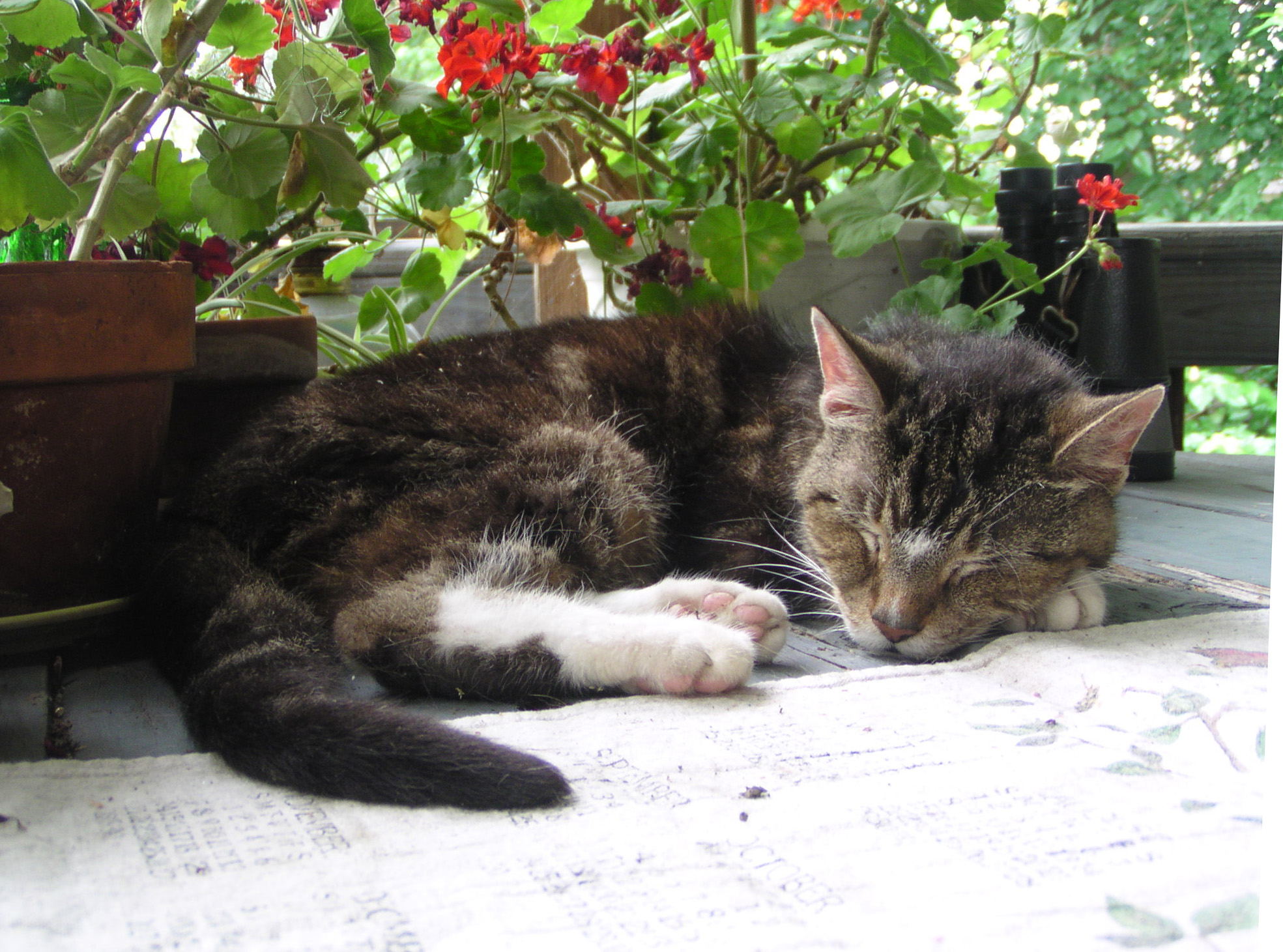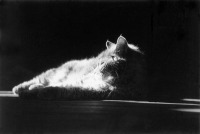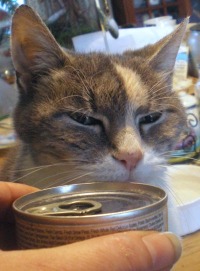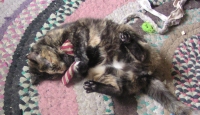Loving Care for Your Senior Cat, Part 1

How old would you guess Stanley is in the photo above? If you know senior cats you may guess, but cats have a unique way of hiding aging from even the most attentive owners. Once cats reach three to four years of age they can go well into their teens before they show signs of physical weakness, arthritis, failing eyesight and hearing and other common ailments of an aging body of any species.
And even then they can often get along just fine with a good diet, lots of love, and a little something extra from their people. Just like senior humans have special needs befitting the physical age of their bodies, our cats will benefit from an appropriate diet and exercise, regular health checks and even some palliative care you may not give to a younger cat.
This was taken during Stanley’s last summer in 2006 when he was, by my best guess 24 years old, having appeared on my porch as an adult in 1986 with a body development that indicated a cat three to five years old.
Definition of “Senior”

“Senior” is as loose a term with cats as it is with humans, and feline aging is not the equivalent of canine aging.
We used to assume that dogs and cats both age, over the course of a lifetime, an average of seven “human” years for every year the animal is alive. Cats, however, tend to live a little longer than dogs, and different breeds of dogs, large to small, are averaged at different “human years” for each “dog year”. Over the course of a lifetime cats may average five “human years” for every “cat year”, but they vary quite a bit at the beginning and end of their lives.
In addition, the age considered “senior” for an animal was, and still is in some cases, only seven years old. More recently, though, other authorities and perhaps even your own veterinarian, differ in opinion, especially for cats, varying from eight to twelve years of age, and for both dogs and cats we have many more categories than kitten/puppy, adult and senior. Read about the age of your cat and its human equivalent.
Cats are living longer and longer, and while reaching the double digits in age used to be quite a milestone, reaching the second decade isn’t unusual.
Annual Exam

From kittenhood, your cat should see the veterinarian yearly as part of her regular care even if there’s no apparent health issue, as a benchmark from one year to the next. If a health problem arises, our cats can’t say to us, “Hmm…I think it was in January that I first noticed that…,” but an observant veterinarian with records from prior annual exams will know if a lump, bump or symptom was present at the previous yearly examination. If you’ve been lax when your kitty was young, and unless your veterinarian indicates any chronic conditions developing, tighten up your schedule when she reaches about ten years of age.
In addition to this yearly checkup, and because health symptoms are that much more likely to arise in an older cat, consider a “senior exam” for your cat between ten and twelve years as well. Many veterinarians and clinics offer these as a matter of course, but be cautious what they include, which is sometimes no more than a regular yearly exam with a basic blood test, but the cost is often considerably more than for a regular annual exam.
The purpose of the senior exam is to determine baseline data on the cat’s major health indicators at an age when everything appears normal. Find an exam that lists not only the procedures but also the conditions or symptoms for which tests are performed: a CBC, or complete blood count, does not include the T-4 or thyroid test, and in some cases does not include measures for BUN and creatinine, the indicators for renal failure, two very common chronic illnesses in older cats that often show early symptoms once a cat reaches double digits in age. So in addition to the usual exam of eyes, mouth, ears, weight, heartbeat and temperature, a geriatric exam should also check your pet’s blood, urine, blood pressure and/or radiographs for problems such as kidney disease, hyperthyroidism or arthritis. None of these conditions may be present, or only the earliest symptoms, but later if you do begin to see changes in your cat’s lifestyle you have a record of her body when she was healthy and your veterinarian has a much more clear starting point for diagnosis.
And it’s not a bad idea to begin giving kitty your own regular “mini-exam”, just checking her over with our own hands and eyes about once per month. You can read about the monthly mini-exam and download a checklist for the “snout to tail wellness assessment”in “Help Your Pets to Stay Well”.
Food and water

If you haven’t already, start reading labels. Your cat may tend to fill out around the middle as she gets older and less active, or she may be a little chubby to begin with simply because she’s less active. While maintaining the proper weight balance is critical as cats age, be careful with weight loss and management.
Cats are “obligate carnivores”, meaning that they must eat protein to maintain their body tissue. While many senior foods may advertise reduced protein content because it’s assumed to be more easily digestible for an older cat or a cat showing early symptoms of renal failure, the only content that should be reduced is calories, just like a human diet or senior program. If protein is changed at all it should only be made more easily digestible, but should still be animal protein, not vegetable protein—what’s difficult to digest is often grains added as protein.
One other change in the food content could be an increase in fiber, obviously necessary as the cats’ digestion changes and constipation may become an issue, also aiding in hairball prevention. You can also add stewed pumpkin to the canned food or just give it to your cat to help with constipation and hairball elimination.
If you currently feed only dry food or leave dry food available all the time, you should begin feeding an increased amount of wet food. It has a stronger smell to attract your cat, is easier to chew and swallow, and the increased moisture content is always a benefit—you can even add water to it to make sure your cat gets as much water as possible. If you feed at specified times, consider feeding an extra meal in between; just like senior people, older cats will eat less at each meal and her digestion can only handle a certain amount, but she needs just as much food through the course of a day.
Feeding at specified times instead of leaving food available all the time is a good idea all through your cat’s life. For one reason, the food is always fresh, and sense of smell is what prompts a cat to eat; with aging this becomes critical. More importantly, monitoring your cat’s dining habits is important as she ages, and a change in her consumption or even her attitude toward mealtime and her food can often be the first early indicators of a health problem.
Most of all, consider the ingredients of your cats’ food, and even consider a limited-ingredient diet with mostly quality protein, or a minimally-processed, home-cooked, or even raw food diet for optimum nutrition to give your senior the most accessible nutrition in each bite of food.
Water is important to cats at all life stages but especially as they age. Adding water to canned food is one way to give your cat more liquids, along with a few other tactics. Despite the fact that the water looks fine, you should change the water in the bowl every day and wash the bowl when you do. You should also keep the bowl separate from food dishes if you leave food out because cats prefer it that way, often feeling their water is unclean when it’s next to their food. Also add extra water dishes around the house so that fresh water is available wherever your senior cat spends time.
Exercise

Kitty may still be racing to the top of the cat tree and running laps in the middle of the night at age 15, but at some point she’ll slow down in either speed or frequency. While it has always seemed that she could sleep 18 hours a day and eat whatever she wanted and still stay in prime physical shape, she may need a little encouragement as she grows older.
Physical activity not only helps to keep her muscles toned, but it also keeps her heart and lungs and circulatory system in good condition, helps with digestion and elimination and even appetite if that starts to wane. Playing with your kitty each day is a great thing to do at any age, but if you don’t already have a playtime with her on a regular basis, find some toys that get her excited to leave around, and some interactive toys so that you can see she gets her exercise. It helps build the bond between the two of you and you can also observe her physical abilities.
References
You can find plenty of references for care for older cats around the internet from The Cornell Feline Health Center to the American Association of Feline Practitioners, where you can download their Friends for Life: Caring for Your Older Cat, a 32-page handbook, and in books such as Complete Care for Your Aging Cat by Amy Shojai and Six Natural Ways to Help Your Cat Live Longer by Liz Eastwood, a book which features Stanley, seen at the beginning of this article.
Part Two, appearing tomorrow on The Creative Cat, will give you tips on optimizing your senior cat’s environment and information about senior illnesses and palliative care.
—————————————
All images and text used on this site are copyrighted to Bernadette E. Kazmarski unless otherwise noted and may not be used in any way without my written permission. Please ask if you are interested in purchasing one as a print, or to use in a print or internet publication.


Pingback: Loving Care for Your Senior Cat, Part 1 | Our A...
Pingback: The Creative Cat - Loving Care for Your Senior Cat
Pingback: Loving Care for Your Senior Cat, Part 1 | Our Aging Pets | Scoop.it
Pingback: The Creative Cat - Beyond Food and Water, Loving Care for Your Senior Cat, part 2
Pingback: The Creative Cat - Daily Photo: Old Friends
Awesome post especially since this is Adopt a Senior Month. My article on senior kitties won a CWA certificate of excellence which I need to update since Merlin is my aging muse with kidney disease. I can only hope he follows in Stanley’s footsteps.
Layla, I’ve been focusing on seniors as much as possible. Thinking about you and Merlin, and so glad he’s still hanging in there! Stanley totally amazed me–he had a lot of things to work out before he left this incarnation. Congratulations on your certificate!